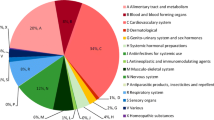Abstract
Background
It is essential that pharmacies and prescribers have an overview of each patient’s medication in order to prevent drug interactions, unintentional co-prescribing, unnecessary polypharmacy and underprescribing. We have assessed this overview by measuring the ‘fidelity coefficient’, a measure of the extent to which a drug user has a preference for one prescriber or one pharmacy.
Methods and setting
Data for all prescriptions issued for the population in Southern Denmark (population 1.2 million) in 2009 was extracted from the Odense University Pharmacoepidemiological Database (OPED). Analysis of the extracted data was then limited to persons with at least ten prescriptions within the year, resulting in 8,246,064 prescriptions issued to 283,388 individuals. For each individual, we identified the most used prescriber and calculated the proportion of all prescriptions accounted for by that prescriber (FCpresc). The individual user’s most frequented pharmacy was also identified and the FCpharm calculated in a similar fashion.
Results
The average FCPresc and average FCPharm were 0.883 (standard deviation 0.158) and 0.927 (0.139), respectively. The estimated difference was 0.0446 (95% confidence interval 0.0439–0.0453). Among the factors associated with a high FCpresc and high FCpharm were older age, male gender and a high volume of prescriptions. The major drug classes that were most often prescribed by a non-main prescriber were beta-lactams, antidepressants and opioids. Similarly, the major drug classes associated with use of non-main pharmacy were beta-lactams, antidepressants and inhaled beta-agonists.
Conclusion
Based on this analysis, both prescribers and pharmacies generally have an equal potential for maintaining an excellent overview of their patients’ medication, but the pharmacies account for a slightly higher proportion of patients.


Similar content being viewed by others
References
Madsen HK, Hallas J (2009) Udvikling I lægemiddelforbruget I Danmark (in Danish). Ugeskr Laeger 171(19):775–777
Department of Health (2004). Prescriptions dispensed in the community: statistics for 1993–2003. London, Department of Health. Available at: http://www.dh.gov.uk/prod_consum_dh/groups/dh_digitalassets/@dh/@en/documents/digitalasset/dh_4094068.pdf
Barat I, Andreasen F, Damsgaard EMS (2000) The consumption of drugs by 75-year-old individuals living in their own homes. Eur J Clin Pharmacol 56:501–509
Glintborg B, Poulsen HE, Dalhof KP (2007) The use of nationwide on-line prescription records improves the drug history in hospitalized patients. Br J Pharmacol 65(2):265–269
Foss S, Schmidt JR, Andersen T, Rasmussen JJ, Damsgaard J, Schaefer K, Munck LK (2004) Congruence on medication between patients and physicians involved in patient course. Eur J Clin Pharmacol 59:841–847
Glintborg B, Andersen SK, Poulsen HE (2009) Prescription data improve the medication history in primary care. Qual Saf Health Care 19(3):164–168
Torrible SJ, Hogan DB (1997) Medication use and rural seniors - who really knows that whey are taking? Can Fam Physician 43:893–898
Warholak TL, McCulloch M, Baumgart A, Smith M, Fink W, Fritz W (2009) An exploratory comparison of medication lists at hospital admission with administrative database records. J Manag Care Pharm 15(9):751–758
Tulner LR, Kuper IMJA, Frankfort SV, van Campen JPCM, Koks CHW, Brandjes DPM, Beijnen JH (2009) Discrepancies in reported drug use in geriatric outpatients: relevance to adverse events and drug-drug interactions. Am J Geriatr Pharmacother 7(2):93–104
Gilchrist WJ, Lee YC, Tam HC, MacDonald JB, Williams BO (1987) Prospective study of drug reporting by general practitioners for an elderly population referred to a geriatric service. Br Med J 294:289–290
Tamblyn RM, McLeod PJ, Abrahamowicz M, Laprise R (1996) Do to many cooks spoil the broth? Multiple physician involvement in medical management of elderly patients and potentially inappropriate drug combinations. Can Med Assoc J 154(8):1177–1184
Green JL, Hawley JN, Rask KJ (2007) Is the number of prescribing physicians an independent risk factor for adverse drug events in an elderly outpatient population? Am J Geriatr Pharmacother 5(1):31–39
Gaist D, Sørensen HT, Hallas J (1997) The Danish prescription registries. Dan Med Bull 44(4):445–448
Hallas J, Dall M, Andries A, Andersen BS, Aalykke C, Hansen JM, Andersen M, Lassen AT (2006) Use of single and combined antithrombotic therapy and risk of serious upper gastrointestinal bleeding: population based case-control study. Br Med J 333(7571):726–730
Bereznicki BJ, Peterson GM, Jackson SL, Walters EH, Fitzmaurice KD, Gee PR (2008) Data-mining of medication records to improve asthma management. Med J Aust 189(1):21–25
Author information
Authors and Affiliations
Corresponding author
Additional information
An erratum to this article can be found at http://dx.doi.org/10.1007/s00228-011-1155-8
Rights and permissions
About this article
Cite this article
Pottegård, A., Hallas, J. Physicians’ and pharmacies’ overview of patients’ medication. An analysis of fidelity coefficients. Eur J Clin Pharmacol 67, 919–924 (2011). https://doi.org/10.1007/s00228-011-1026-3
Received:
Accepted:
Published:
Issue Date:
DOI: https://doi.org/10.1007/s00228-011-1026-3




